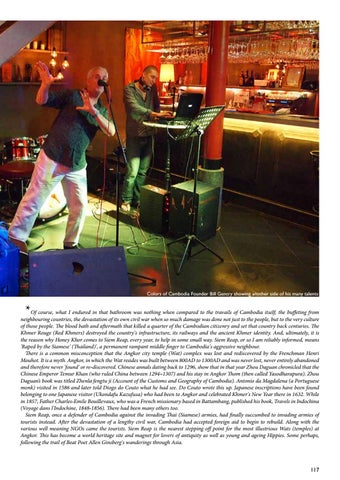Colors of Cambodia Founder Bill Gentry showing another side of his many talents
*
Of course, what I endured in that bathroom was nothing when compared to the travails of Cambodia itself; the buffeting from neighbouring countries, the devastation of its own civil war when so much damage was done not just to the people, but to the very culture of those people. The blood bath and aftermath that killed a quarter of the Cambodian citizenry and set that country back centuries. The Khmer Rouge (Red Khmers) destroyed the country's infrastructure, its railways and the ancient Khmer identity. And, ultimately, it is the reason why Honey Khor comes to Siem Reap, every year, to help in some small way. Siem Reap, or so I am reliably informed, means 'Raped by the Siamese' (Thailand)', a permanent rampant middle finger to Cambodia's aggressive neighbour. There is a common misconception that the Angkor city temple (Wat) complex was lost and rediscovered by the Frenchman Henri Mouhot. It is a myth. Angkor, in which the Wat resides was built between 800AD to 1300AD and was never lost, never entirely abandoned and therefore never 'found' or re-discovered. Chinese annals dating back to 1296, show that in that year Zhou Daguan chronicled that the Chinese Emperor Temur Khan (who ruled China between 1294–1307) and his stay in Angkor Thom (then called Yasodharapura). Zhou Daguan’s book was titled Zhenla fengtu ji (Account of the Customs and Geography of Cambodia). Antonio da Magdalena (a Portuguese monk) visited in 1586 and later told Diogo do Couto what he had see. Do Couto wrote this up. Japanese inscriptions have been found belonging to one Japanese visitor (Ukondafu Kazufusa) who had been to Angkor and celebrated Khmer's New Year there in 1632. While in 1857, Father Charles-Emile Bouillevaux, who was a French missionary based in Battambang, published his book, Travels in Indochina (Voyage dans l'Indochine, 1848-1856). There had been many others too. Siem Reap, once a defender of Cambodia against the invading Thai (Siamese) armies, had finally succumbed to invading armies of tourists instead. After the devastation of a lengthy civil war, Cambodia had accepted foreign aid to begin to rebuild. Along with the various well meaning NGOs came the tourists. Siem Reap is the nearest stepping off point for the most illustrious Wats (temples) at Angkor. This has become a world heritage site and magnet for lovers of antiquity as well as young and ageing Hippies. Some perhaps, following the trail of Beat Poet Allen Ginsberg's wanderings through Asia.
117
